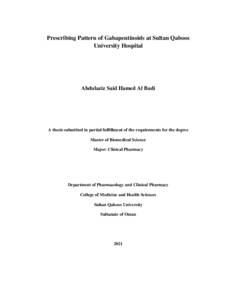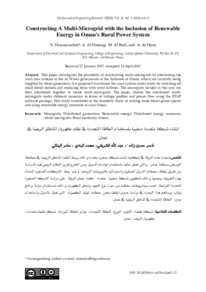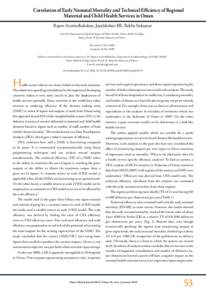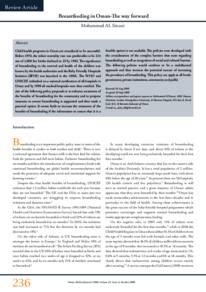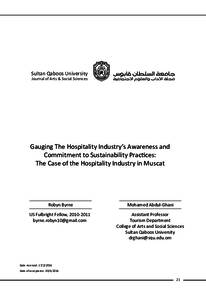Document
Prescribing pattern of Gabapentinoids at Sultan Qaboos University Hospital.
Identifier
Al-Badi, Abdulaziz Said Hamed (2021). Prescribing pattern of Gabapentinoids at Sultan Qaboos University Hospital. ( Master thesis. Sultan Qaboos University, Muscat, Oman).
Publisher
Sultan Qaboos University.
Gregorian
2021
Language
English
English abstract
Introduction: the gabapentinoids gabapentin and pregabalin, which were originally developed as adjunct anticonvulsants, are now repurposed for a wide range of clinical conditions. The use of gabapentinoids since they have been introduced into the market in 1994 has increased substantially worldwide, and this use is still rising annually. Despite the pharmaceutical labels that these agents are well tolerated, several recent reports revealed that they possess addictive liability and can produce effects similar to those of traditional recreational drugs, including significant euphoric effects (a cannabis-like high), improved sociability, and relaxation. Objectives: To describe the prescribing pattern of gabapentinoids (pregabalin and gabapentin) at Sultan Qaboos University Hospital (SQUH). Methods: This study was a retrospective cross-sectional in nature. It was conducted at SQUH. All adult patients (18 years and above) who were prescribed gabapentinoids in the period of 1st of March 2019 to 31st of August 2019 were included. Data related to patients were collected. Results: The study analyzed a total of 291 prescriptions. Most of the patients were females (178, 61.2%) and the most frequent age group was 60 years and above accounting for (190, 65.3%). There were (81,28.0%) patients who were diagnosed with orthopedic conditions out of which (35,12.0%) had back pain. About (230,79.0%) of patients had cardiovascular conditions as comorbidity, where HTN was the most common condition. Consultants and senior consultants were the most common prescribers (19.6%). Most pregabalin prescriptions (223,76.6%) were prescribed in outpatients setting compared with inpatients (21,7.2%). On the other hand, almost all gabapentin prescription was given in outpatients setting (41,14.1%) with only (3,1.0%) of prescriptions as inpatients. Regarding the episode category, pregabalin was either prescribed as a follow-up or refill in (96,33.0%) and (84,28.9%) of prescriptions, respectively. Similarly, gabapentin was prescribed in a follow up in (20,6.9%) or refill in (13,4.5%) of prescriptions. Labeled indication accounted for (36,14.5%) of pregabalin prescription while it was only one (2.3%) for gabapentin. Off-label use was observed in (97,39.2%) and (21,47.7%) for pregabalin and gabapentin prescriptions, respectively. Among all the off-label use, low back pain was the most common for both agents. Most of the dosing regimen for labeled and off-label indications was found to be within FDA-
V
recommended doses in (125,98.4%) and (22,100%) of pregabalin and gabapentin prescriptions, respectively. Cardiovascular agents were found to be the most co-prescribed classes of drugs (437,34.4%) with aspirin as the most co-prescribed drug (78,6.1%). A total of (54,19.0%) patients were found to be using at least one controlled drug. Tramadol (18,6.2%) was the most commonly used controlled drug. Conclusions: Our findings indicate that there is a high proportion of unapproved indications for pregabalin and gabapentin. Awareness programs and the establishment of policy for the use of these agents are needed to improve their rational use.
Member of
Resource URL
Category
Theses and Dissertations

